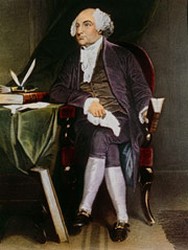John Adams And The Constitution
|
| updated |
Copy Link Code
|
 John Adams was one of the most influential Founding Fathers and he played a significant role in the formation of the U.S. government structure that we recognize today. Although he was serving as a diplomat in Europe and therefore could not physically attend the Constitutional Convention, John Adams' Defense of the Constitutions of 1787 laid out his arguments in favor of state and federal governments based on bicameral legislature and separate branches that balance power. He was responding to criticism from European political thinkers who thought that America, without an aristocratic class, did not need separate legislative houses. Adams disagreed by pointing out that wealthy men in the United States would just as quickly dominate the lower house if they were not separated. In his own state, John Adams' Massachusetts Constitution, penned mostly by Adams himself in 1780, laid the groundwork for the design of the U.S. Constitution seven years later. Adams understood the necessity of checks and balances years before James Madison would define them in his Federalist Papers.
John Adams was one of the most influential Founding Fathers and he played a significant role in the formation of the U.S. government structure that we recognize today. Although he was serving as a diplomat in Europe and therefore could not physically attend the Constitutional Convention, John Adams' Defense of the Constitutions of 1787 laid out his arguments in favor of state and federal governments based on bicameral legislature and separate branches that balance power. He was responding to criticism from European political thinkers who thought that America, without an aristocratic class, did not need separate legislative houses. Adams disagreed by pointing out that wealthy men in the United States would just as quickly dominate the lower house if they were not separated. In his own state, John Adams' Massachusetts Constitution, penned mostly by Adams himself in 1780, laid the groundwork for the design of the U.S. Constitution seven years later. Adams understood the necessity of checks and balances years before James Madison would define them in his Federalist Papers.
John Adams may have not foreseen the judgment of the Constitutional Convention members to completely replace the Articles of Confederation instead of edit it as was originally planned, but he would support the endeavor they undertook to strengthen the national government. Adams was a federalist (the Federalist Party did not exist yet, but the concept of federalism did) and believed that the strength of the new nation would depend on the tightness of its unity. For John Adams, Constitutional Convention members were the targets of encouraging letters that praised their mission as urgent and necessary to build a stronger republic. Thomas Jefferson, also serving as a diplomat in Europe and therefore unable to attend the Convention, sent his friend Adams a letter that described the Constitutional Convention members in glowing terms. John Adams and the Constitution he had written for Massachusetts were certainly relevant in the background of proceedings at the Constitutional Convention, but it was James Madison who stole the show and planned the structure of the three branches with their checks and balances. Madison had a few ideas that did not last, including the nomination of judges by the legislature instead of the executive and the power of the federal legislature to nullify state laws.
John Adams' Constitution ideas included abandoning the slave trade without abolishing slavery. This endeavor was undertaken by the Constitutional Convention members who agreed that the slave trade should cease in America by 1808. However, while a Quaker member from Delaware spoke inspirationally about the cause of abolition and the sin of slavery, most members agreed that the issue could not be decided at this time without dividing the nation. Little did they know how far the nation would divide only decades later when the question of slavery arose again. Adams had always felt that slavery was wrong, but had himself opposed legislation in Massachusetts in 1777 which would have abolished slavery at the local level because he felt the issue was too divisive even in that New England state. He said that the legislation should "sleep for a time." As we know, abolition did sleep for a time and awoke to a national nightmare of epic proportions in the Civil War.
